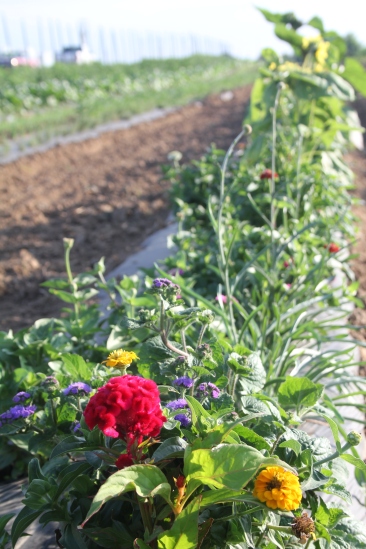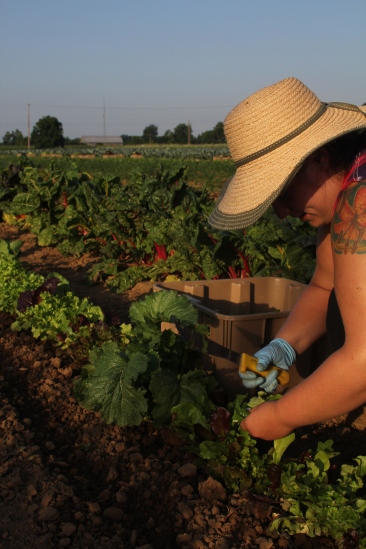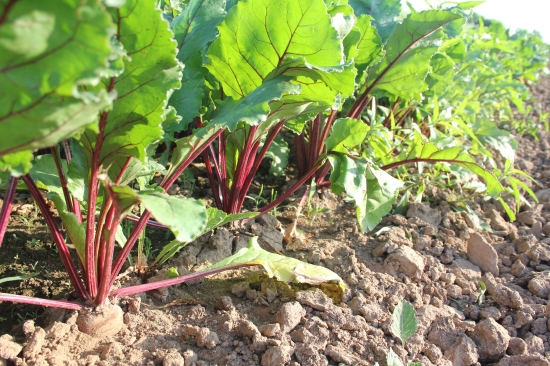Farm Notes
This week we are opening up the U-Pick fields! We are growing a few crops specifically for folks who want to come out to the farm and U-Pick. Some of these crops you may also receive in your share (i.e. green beans and basil), while others are only being grown for U-Pick (i.e. flowers, okra, and cherry tomatoes). You may come to the farm for U-Pick anytime during the normal farm hours, Monday through Friday, 7:30am-4:00pm. The farm is not available for U-Pick on the weekends or outside of these hours.
Every week, we will list what is available in the weekly newsletter (see below). On your first visit, we ask that you find one of the organic team (in the organic shed or out in the fields) for a U-Pick orientation. You will need to bring your own harvest containers and your own pruners or scissors.
Additional notes:
• Please no pets
• Please stay out of fields not specified in the newsletter as containing U-Pick crops (most crops will be in the field adjacent to the parking lot)
• U-Pick privileges are limited to primary/secondary shareholders, but please feel free to bring your grandchildren, visiting family members, etc. with you when you come.
• Please drive slowly
How to get here:
The Horticulture Research Farm is located on the southwest corner of Man-O-War and Nicholasville Road. From the UK campus, head south (towards Nicholasville) on Nicholasville Road. Turn right onto Man-O-War Boulevard. Take the first left turn (there is a stoplight) onto the farm. Stay straight on the farm road, go past the residence on your left and the greenhouses on the right. Please park in the small parking lot on your left.
Note from an Apprentice
by Caroline Engle
Hello! My name is Caroline Engle and I’m a junior double majoring in natural resources/environmental science and agricultural economics, with a minor in sustainable agriculture. I love learning and have many passions from studying climate change policy to water conservation and mountaintop removal activism. My family has always had a garden and throughout my life I’ve learned the importance of local foods due to its carbon footprint, nutritional value, and connection to community; however, I had no experience farming outside backyard produce. Since I started working at the CSA farm I can honestly say that I’ve learned more working on the farm for the past three weeks than any three weeks spent in a classroom. I’ve learned various cover crop combinations, how to harvest a variety of crops, how to use a vacuum seeder, insect and weed identification, drip irrigation installation and maintenance, and even how to drive a tractor. The learning I’ve experienced at the farm is not traditional learning like studying a textbook or reading endless research articles — it’s hard work that mentally and physically challenges you. Through blisters and numerous hot afternoons, I’ve finally learned how to post tomatoes without having to bend over or wrestle with string.

Caroline ready to tie tomatoes!
The learning I’ve experienced is also more emotion-driven than typical schoolwork as well. I’m continuously amazed by the inherent connection between the land and our health as I come back day after day watching seeds germinate to something beautiful and delicious. I’ve learned the power of community and working together to feed a group of people healthy, pesticide-free food because as a community we believe that’s the right thing to do. Organic farming for the CSA has been a huge educational experience for me, and luckily it’s something I can do every day this summer knowing that there’s still so much more to learn.
What’s In Your Share
For June 19th, you’ll find:
+ Cabbage
+ Kohlrabi
+ Beets
+ Salad Mix
+ Green Onions
+ Chard
+ Squash and Zucchini
+ Cilantro or Dill
+ Radishes
The following crops are available for U-Pick:
+ Flowers — the flowers are still small, but there will be plenty more in the weeks to come as the plants continue to grow!
+ Herbs — please take selective cuttings from the herbs, and leave the plant some leaves to continue to grow.
Veggie Tips
+ Cabbage is another member of the Brassica plant family. They can be eaten raw or cooked, but cooking releases their beneficial elements, which includes vitamins K and C and amino acids with anti-inflammatory properties. Be wary of overcooking cabbage, however; 5-10 minutes of simmering or steaming will do the trick. You can also eat the core of the cabbage if you slice it thinly.
+ Chard – along with Beets, Spinach, and a host of edible weeds – are in the Amaranth plant family. These colorful leafy greens have vitamins A, C, K, B, E as well as magnesium, iron, potassium and fiber – all in a package with almost no calories. In short, it’s a nutritional powerhouse! You can eat chard raw, though we recommend cutting it up in small pieces for salads. Most people prefer chard steamed or sautéed. When cooked, chard leaves retain more bulk than spinach leaves. The ribs of chard are edible, but they will take longer to cook. Consider removing the leafy part from the ribs first and cook separately. Ribs can also be used in any vegetable stock. Try pairing Chard with lentils or potatoes. It can also be used to bulk up soups, stuff lasagna, or as an addition to quiche.
+ The Beets in your share are coming with greens attached! The greens are highly nutritious – in addition to having vitamins A, B1, B2, B6, C, calcium, iron, phosphorus, sodium, magnesium, and copper like the beet root itself contains, the leaves also have choline and folate. Cut the tops off soon after taking them home, and you can use them as you would spinach. Mix them with other greens, wilt them, toss with pasta, add them to soup… there are many uses for these edible greens! The stems of the leaves are not usually eaten, though you can use them in soup stock.
Recipes
Radish Tea Sandwiches with Creamy Dill Spread
From Eating Well magazine
Ingredients:
4 oz reduced fat cream cheese or creamy goat cheese
2 Tbsp chopped fresh dill, plus sprigs for garnish
1 Tbsp capers, rinsed and chopped
1/8 tsp freshly ground pepper, plus more for garnish
12 slices cocktail size thin pumpernickel or rye bread
6-8 medium radishes, thinly sliced
Directions:
Mash cream cheese (or goat cheese), chopped dill, capers, and 1/8 tsp of pepper in a small bowl until well combined. Spread about 2 tsp of the mixture on each piece of bread. Top each with a few radish slices, a spring of dill, and a generous grinding of pepper. Makes 12 tea sandwiches.
Grilled Green Onions
Ingredients:
1 bunch green onion
1/2 teaspoon garlic salt
1/2 teaspoon black pepper
2 tablespoons butter
Directions:
1. Wash the onions thoroughly.
2. Place whole onions on a sheet of foil.
3. Place the butter over the onions.
4. Sprinkle with garlic salt and pepper.
5. Fold the foil over the onions and seal the edges so the butter steams the onions.
6. Place on a hot grill until warmed through, about 10 minutes.
7. Be careful when opening, the steam will be hot.
Another grilled vegetable recipe to try: Grilled Cabbage!
Russian Cabbage Borscht
From Moosewood Cookbook
Ingredients:
2 tablespoons butter
1-1/2 cups chopped onion
1-1/2 cups thinly sliced potato
1 cup thinly sliced beets
1 large sliced carrot
1 stalk chopped celery
3 cups chopped cabbage
1 scant teaspoon caraway seeds
(optional: 1 tablespoon raisins)
4 cups stock or water
2 teaspoons salt
Black pepper
1/4 teaspoon dill weed
1 tablespoon plus 1 teaspoon cider vinegar
1 tablespoon plus 1 teaspoon honey
1 cup tomato puree
Directions:
Place potatoes, beets and water in a saucepan and cook until everything is tender (save the water). Begin cooking the onions in the butter in a large kettle. Add caraway seeds and salt. Cook until onion is translucent, then add celery, carrots and cabbage. Add water from beets and potatoes and cook, covered until all the vegetables are tender. Add potatoes, beets and remaining ingredients. Cover and simmer slowly for at least 30 minutes.
Herb, Chard, and Feta Soup
From bon appétit
Ingredients:
SOUP
2 tablespoons olive oil
1 large onion, coarsely chopped
2 garlic cloves, crushed
1 pound Swiss chard leaves (center ribs and stems removed) or spinach, coarsely chopped (about 10 cups)
3 1/2 cups vegetable broth
1 cup coarsely chopped flat-leaf parsley
1/2 cup coarsely chopped fresh cilantro
1/4 cup fresh mint leaves
1 tablespoon dried mint
1 teaspoon freshly grated nutmeg
1 tablespoon fresh lemon juice
Kosher salt and freshly ground black pepper
GARNISHES
5 ounces plain Greek-style yogurt (about 1/2 cup)
1/2 cup mixed chopped herbs (such as parsley, cilantro, and mint), divided
4 ounces feta, crumbled, divided
Kosher salt and freshly ground black pepper
Fresh lemon juice (optional)
Olive oil (optional)
Directions:
SOUP
Heat oil in a large saucepan over medium heat. Add onion and garlic and cook, stirring often, until translucent and soft (do not brown), 7–8 minutes. Stir in chard, broth, parsley, cilantro, fresh and dried mint, and nutmeg. Bring to a boil, reduce heat, and simmer, stirring occasionally, until chard is tender, about 10 minutes. Stir in lemon juice and season to taste with salt and pepper. Working in batches, purée soup in a blender until smooth. Return to pan. DO AHEAD: Can be made 8 hours ahead. Cover and chill. Rewarm soup before continuing.
GARNISHES
Place 1/3 of yogurt in a medium bowl. Add 1/2 cup warm soup; whisk until smooth. Repeat process twice more, adding a total of 1 cup more soup. Whisk yogurt mixture into soup in saucepan. Stir 1/4 cup herbs and half of feta into soup. Season to taste with salt, pepper, and lemon juice, if desired.
Ladle soup into bowls and garnish with remaining 1/4 cup herbs and 2 oz. feta. Drizzle with oil, if desired.





Way to Go Caroline! Best wishes, Ford Waterstrat